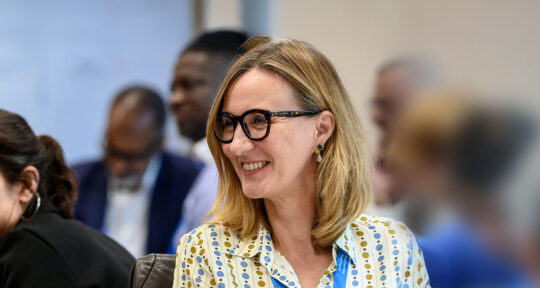What is unconscious bias and how to avoid it in the workplace?
Unconscious biases, also known as implicit bias, refer to automatic, deeply ingrained stereotypes that affect how we perceive and interact with others, without even realizing it. These biases help us navigate the world quickly (but often unfairly) by making assumptions based on characteristics like race, gender, age, or background.
While everyone holds unconscious biases, their influence on decision-making can lead to discrimination, inequality, and exclusion in the workplace.
In this article, we’ll explore the common types of unconscious bias, examine how it affects the workplace, and offer actionable strategies to overcome it.
- Understanding unconscious bias in the workplace
- Implicit bias vs. unconscious bias: is there a difference?
- Common types of unconscious bias
- How to identify unconscious bias in yourself and others
- Real-world evidence of unconscious bias
- How to address unconscious bias?
- Unconscious bias in AI systems: When machines inherit human prejudice
- Moving forward: Leading with awareness and accountability
Understanding unconscious bias in the workplace
To overcome unconscious bias in the workplace, it’s crucial to understand where it originates. Most unconscious biases are formed early in life, shaped by family upbringing, cultural norms, media exposure, and personal experiences. Research shows that racial bias can start to develop as early as age seven.
As individuals grow, these learned associations become deeply embedded and are reinforced over time. In fast-paced or high-stress environments—like many workplace scenarios—the brain often relies on mental shortcuts to make decisions quickly. These shortcuts, or cognitive biases, can lead to unfair judgments without the person even realizing it.
How unconscious bias affects the workplace
The effects of unconscious bias at work can be far-reaching. Even when unintentional, bias can shape decisions related to:
- Recruitment: Favoring candidates with similar backgrounds, experiences, or names.
- Promotions: Perceiving certain employees as more “leadership material” based on stereotypes.
- Team dynamics: Overlooking or excluding contributions from underrepresented voices.
For example, a hiring manager may unconsciously associate leadership with assertiveness, and assertiveness with male candidates, resulting in gender bias during leadership selection.
But gender bias is just one form of unconscious bias. Others, like ageism, affinity bias, or confirmation bias, are equally pervasive and often go unnoticed in daily workplace interactions.
Let’s take a closer look at some of the most common types of unconscious bias you may encounter at work.
Implicit bias vs. unconscious bias: is there a difference?
While often used interchangeably, implicit bias is more commonly used in academic and psychological contexts, whereas unconscious bias is more frequently used in organizational and workplace settings. Both refer to automatic attitudes or stereotypes that influence our decisions without conscious awareness.
Similarly, it’s helpful to distinguish between conscious and unconscious bias: conscious bias is intentional and explicit, while unconscious bias happens without intent, yet can be just as harmful in the workplace.
Common types of unconscious bias
Recognizing specific biases is the first step toward reducing them. Here are some of the most common types of unconscious bias in the workplace:
Affinity bias
Affinity bias, also known as similarity bias, refers to the tendency to favor people who share characteristics with us, such as background, interests, values, or appearance. This often leads to the formation of exclusive “in-groups” and the unintentional exclusion of those who are perceived as “different.”
Example: A manager might be more inclined to promote an employee who attended the same university, even if another candidate is more qualified.
Confirmation bias
Confirmation bias is the tendency to search for, interpret, and remember information in a way that confirms pre-existing beliefs, while disregarding or downplaying evidence that contradicts them.
Example: A team leader believes remote workers are less productive. As a result, they notice every delay from remote team members but ignore similar delays from those in the office.
Ageism
Ageism involves stereotyping or discrimination against individuals based on their age. This can affect both older and younger employees, but it’s particularly common in hiring and promotion processes for workers over 45.
Example: A recruiter may assume that an older candidate isn’t familiar with digital tools, even when the candidate’s resume clearly shows relevant experience.
According to the AARP, nearly two out of three workers aged 45 and older have seen or experienced age discrimination on the job. This not only limits career opportunities for older professionals but also reduces the talent pool for employers.
Gender bias
Gender bias refers to the preferential treatment or assumptions made about someone based on their gender. This can manifest in evaluations, pay, leadership opportunities, or day-to-day interactions.
Example: In performance reviews, men may be described as “assertive” while women displaying the same behavior are called “aggressive” or “abrasive.”
The gender pay gap remains a global issue. As of 2022, women in the U.S. earned 82 cents for every dollar earned by men, according to the U.S. Bureau of Labor Statistics. Moreover, women are underrepresented in leadership roles, holding just 28% of C-suite positions globally.
Halo effect
The halo effect happens when one positive attribute—such as charisma, appearance, or confidence—leads people to perceive someone more favorably in unrelated areas.
Example: An employee who speaks confidently in meetings may be rated highly on leadership potential, even if they lack technical skills or follow-through.
The halo effect can distort performance evaluations and hiring decisions. It may also create blind spots in leadership pipelines by overvaluing style over substance.
Horn effect
The horn effect is the inverse of the halo effect. It occurs when one negative trait or impression—such as nervousness, untidiness, or a mistake—leads people to form an overall unfavorable opinion of someone, even in unrelated areas.
Example: A job candidate who stumbles during their introduction may be perceived as less competent overall, regardless of their actual qualifications.
Anchor bias
Anchor bias occurs when people rely too heavily on the first piece of information they receive (the “anchor”) when making decisions or judgments—even if it’s irrelevant or arbitrary.
Example: In salary negotiations, the first figure mentioned often sets the tone for the entire conversation, even if it’s far from the market value. This can skew perceptions of fairness and influence outcomes unfairly.

How to identify unconscious bias in yourself and others
As we’ve seen, unconscious bias can take many forms and often goes unnoticed in everyday workplace decisions. Uncovering unconscious bias requires reflection and feedback. Recognizing it within ourselves is not always easy, but there are tools and practices that can help surface these hidden assumptions.
Consider these methods:
Implicit Association Tests (IAT)
These online tools are designed to uncover hidden biases by measuring the strength of associations between concepts. Participants are asked to rapidly categorize words or images, revealing unconscious preferences or aversions based on reaction time.
Harvard University’s Project Implicit offers widely used IATs that focus on race, gender, age, weight, and more. While not diagnostic, IATs are a useful starting point for self-awareness and team training.
Self-assessment
Taking time to reflect on your own beliefs and behaviors is key. Consider how your upbringing, culture, education, and media exposure may have shaped your assumptions about others.
Journaling, guided bias reflection exercises, or working with a coach can help make these thought patterns more visible. Pay attention to recurring judgments you make, especially when they’re automatic.
Peer feedback
Colleagues often notice things we don’t. Invite feedback from trusted peers, mentors, or team members about how your decisions, comments, or actions might be perceived.
This can be done through informal check-ins or anonymous 360° reviews. While it may feel uncomfortable, this kind of input can uncover blind spots and support personal growth.
Real-world evidence of unconscious bias
While unconscious bias can often feel abstract or difficult to pinpoint, real-world studies and legal cases reveal just how impactful and measurable it can be. From hiring decisions to promotion practices, bias consistently shapes workplace outcomes in subtle but significant ways.
Below are three well-documented examples that illustrate how unconscious bias plays out in practice.
1. Name bias in hiring practices
Scenario: A landmark study by economists Marianne Bertrand and Sendhil Mullainathan revealed that job applicants with White-sounding names received 50% more callbacks for interviews than those with African American–sounding names, despite having identical resumes.
This study highlights how unconscious biases can influence hiring decisions, leading to systemic disadvantages for certain groups
2. Gender bias in leadership roles
Scenario: In the case of Juarez v. AutoZone Stores, Inc., Rosario Juarez, a female employee, was awarded $185 million in damages after a jury found that she faced gender discrimination, including being passed over for promotions in favor of less qualified male colleagues.
This case exemplifies how unconscious gender biases can manifest in promotion practices, hindering women’s advancement in the workplace.
3. Maternal bias in the workplace
Scenario: A well-known study published in the American Journal of Sociology found that job applicants who were mothers were offered on average $11,000 less in starting salary than equally qualified non-mothers, and were 79% less likely to be hired. Fathers did not experience these negative effects—in fact, they were sometimes rated more favorably than men without children.
This illustrates maternal bias, a form of unconscious bias in which working mothers are perceived as less competent or committed to their jobs, often leading to missed opportunities for advancement or leadership.
How to address unconscious bias?
Addressing unconscious bias requires education. Learning about real-world instances of bias and its implications, like the case studies above, is a good first step. Recognizing bias further demands ongoing self-reflection using the techniques described above, like the IAT.
Organizations can also take steps to combat bias. Helpful measures to implement include:
- Diversifying hiring practices. Combat bias during recruiting by making sure job descriptions use inclusive language, standardizing the interview process and questions, and being careful of bias resulting from video interviews. For example, background noises or images beyond a candidate’s control in a Zoom call can generate unconscious bias.
- Instituting mentorship programs. Mentorship programs can be useful in combating bias. Mentors rarely pair with direct reports, so they aren’t attached to the individual’s role in the company and can be more objective in their thinking. Mentorship can also help elevate those who may be unseen or otherwise negatively affected by bias.
- Implementing unconscious bias training. Unconscious bias training goes a step beyond raising awareness in the workplace. It teaches people how to recognize how bias impacts their behavior – and to then change that behavior.
Why addressing unconscious bias isn’t enough
Many organizations have launched diversity, equity, and inclusion (DEI) initiatives in recent years, but progress remains limited. According to McKinsey’s State of Organizations 2023 report, while DEI is a clear priority for many companies, these efforts often fail to deliver meaningful change.
This disconnect suggests that awareness alone isn’t sufficient. Without action to recognize and mitigate unconscious bias, well-intentioned initiatives may fall short. To build truly inclusive workplaces, organizations must move beyond surface-level strategies and embed bias-reduction into hiring, leadership development, and decision-making processes.
Unconscious bias in AI systems: When machines inherit human prejudice
Unconscious bias doesn’t just live in human decision-making—it can also be embedded in the technologies we build. As artificial intelligence (AI) plays a growing role in hiring, performance evaluation, and employee engagement, it’s crucial to recognize how human bias can be transferred into automated systems.
AI systems are trained on historical data—data that often reflects existing inequalities. If not carefully audited, these models can replicate and even amplify unconscious bias at scale.
Real-world example: Amazon famously scrapped a recruiting algorithm after discovering it consistently downgraded resumes that included the word “women’s,” such as “women’s chess club captain.” The model had been trained on past hiring patterns that favored male candidates.
AI decisions are often perceived as objective—but if the underlying data is biased, the outputs will be too. In HR, this can lead to discriminatory hiring, skewed performance reviews, or exclusionary internal tools.
What organizations can do:
- Audit datasets for representation and balance before training models.
- Involve diverse stakeholders in the design and review process.
- Establish AI ethics guidelines to assess fairness, explainability, and accountability.
Bias in AI isn’t just a technical problem—it’s a leadership issue. Companies must apply the same awareness and rigor to machine decision-making as they do to human judgment.
Moving forward: Leading with awareness and accountability
Unconscious bias is part of being human—but so is the ability to reflect, grow, and lead with intention. As today’s workplaces become more diverse and interconnected, organizations that prioritize fairness and inclusion will be better positioned to adapt, innovate, and thrive.
Addressing unconscious bias isn’t a one-time effort. It’s an ongoing process that demands curiosity, courage, and accountability—from individuals, teams, and leadership alike. Whether you’re refining hiring practices, designing learning programs, or simply paying closer attention to your daily decisions, every step counts.
At IMD, we believe inclusive leadership is a strategic advantage. Through challenge-based learning and real-world application, our programs help executives develop the mindset and tools to lead change—starting with themselves.
If you’re ready to take the next step, we’re here to help.
Stay up to date 💌
Join the IMD Community.
Stay informed with our latest insights on leadership, strategy, digital transformation and more. Explore fresh perspectives from IMD business school to help you navigate today’s complex business landscape.




